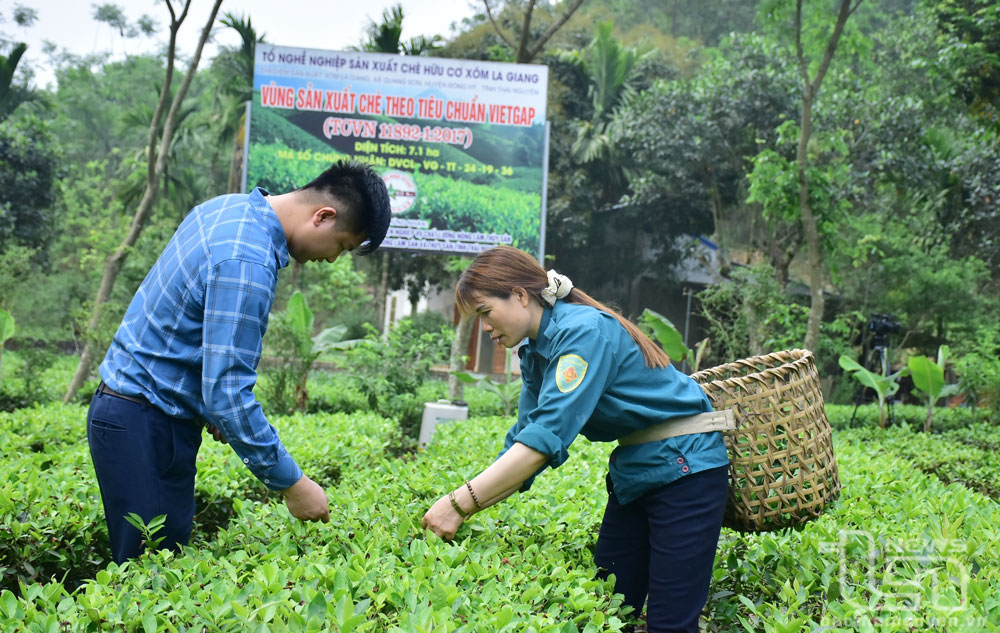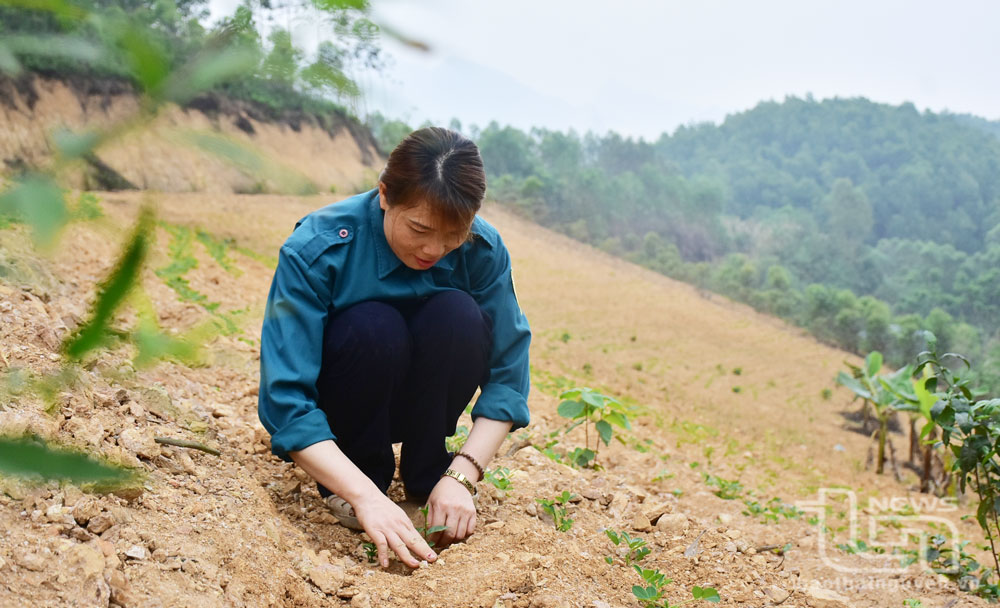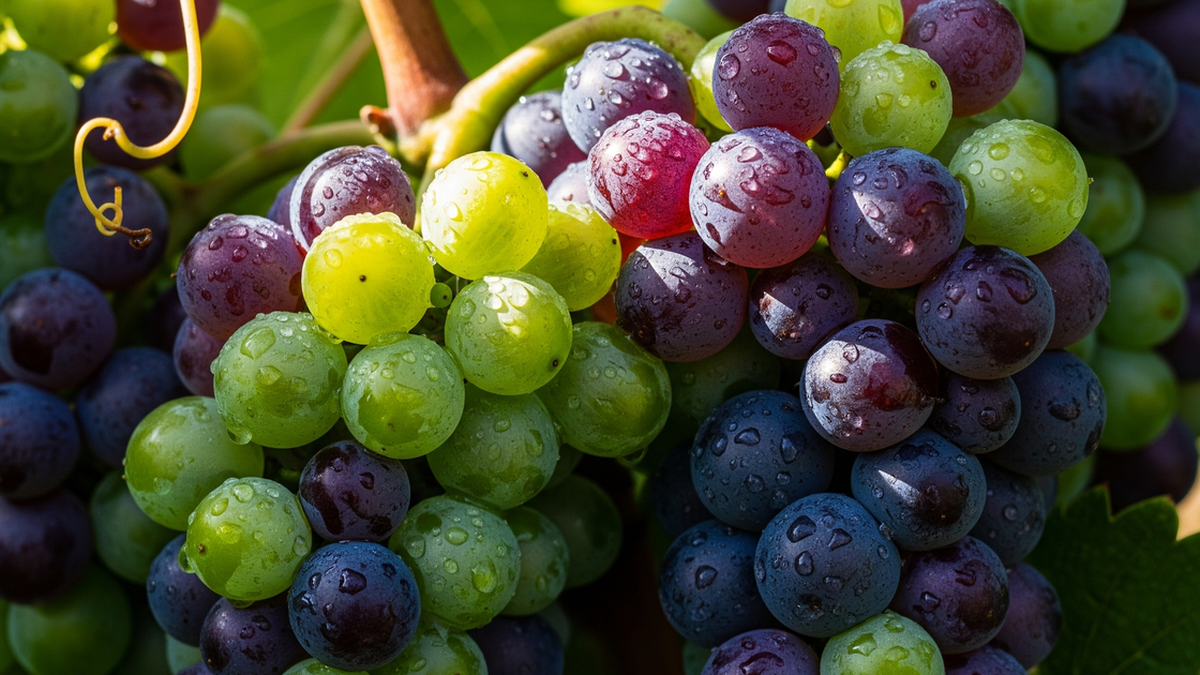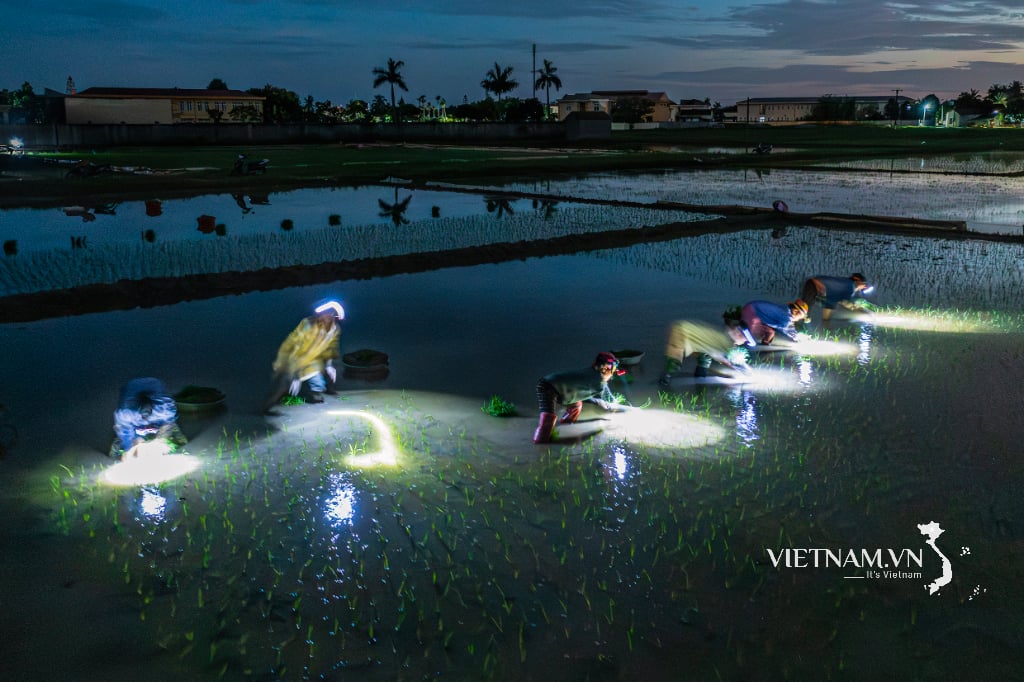 |
| The family of Ms. Vi Thi Phuong (Head of the La Giang Organic Tea Production Professional Group, Quang Son Commune, Dong Hy) still maintains over 3,000m2 of midland tea, cared for according to VietGAP standards, organic orientation. |
According to many documents, the midland tea variety originated from Phu Tho , and was brought back to Tan Cuong commune (Thai Nguyen city) by Mr. Doi Nam (real name Vu Van Hiet) and Thai Nguyen people to plant in Tan Cuong commune (Thai Nguyen city) since the 1920s. Thanks to the suitable climate and soil, the tea tree grows well, giving outstanding product quality.
From Tan Cuong, considered the "capital" of tea, midland tea gradually spread and was widely grown in many localities in the province such as Dong Hy, Dai Tu, Phu Luong, Dinh Hoa..., contributing to the formation of large raw tea growing areas in the province.
The characteristics of midland tea are: small, elongated, dark green leaves; rough stem. When processed, the tea leaves are dark green, evenly curled. Brewed, the tea produces a golden yellow water like honey, with a hint of young rice aroma, a slightly astringent taste on the tip of the tongue but a long-lasting sweet aftertaste, the flavor that makes the famous Thai Nguyen tea brand. However, over time, the midland tea variety has gradually been replaced by new tea varieties with high productivity and beautiful appearance.
Mr. Nguyen Thanh Duong, a long-time tea grower in Hong Thai 2 hamlet, Tan Cuong commune, also hesitated between keeping or abandoning the midland tea variety. But after many trips, many tea competitions and feedback from the market, he decided to keep his family's ancient midland tea garden, renovate and take good care of it.
From that love, he founded the Tan Cuong Midland Tea Cooperative, specializing in producing and developing products from this native tea variety. He shared: Midland tea is grown from seeds, so the plants are very durable, resistant to pests and diseases, and can be exploited for dozens, even hundreds of years. In particular, it produces products with a strong flavor, suitable for demanding customers, those who still remember the strong astringent and sweet aftertaste of Thai Nguyen tea.
Currently, the raw tea area of Tan Cuong midland tea cooperative has more than 20 hectares, of which midland tea accounts for over 50%. Many products have appeared on the market such as: Premium Tan Cuong midland tea, Tan Cuong tea with West Lake lotus, Tan Cuong tea with dried tea leaves... Each month, the cooperative sells 5-7 tons of dried tea buds, with a revenue of about 2 billion VND.
In Quang Son commune (Dong Hy), Ms. Vi Thi Phuong's family in La Giang hamlet also owns 6,000m3 of tea, of which 50% is midland tea. Realizing the superiority of midland tea, she has newly planted more than 3 sao, half of which is midland tea sown with seeds and seedlings.
 |
| Ms. Vi Thi Phuong's family planted 3 more sao of midland tea. |
From this tea variety, Ms. Phuong applies organic farming techniques, combining with diverse product processing. She shared: Compared to hybrid tea, midland tea brings much higher value. I can take advantage of young buds, young leaves and flower buds to make products such as: dried tea buds, bancha tea, black tea, camellia buds, stir-fried tea, fried tea pickles... The selling price ranges from 200,000 to 1,000,000 VND/kg, depending on the type.
Khe Coc Hamlet (Tuc Tranh Commune, Phu Luong) is currently one of the areas that still preserves a large area of midland tea, with more than 200 hectares. Thanks to the terrain consisting of gently sloping "bowl" hills and a mild climate, this place is especially suitable for this native tea variety to grow and develop better than other hybrid tea varieties.
According to Mr. To Van Khiem, Director of Khe Coc Safe Tea Cooperative, if cared for equally, midland tea, although has a slightly lower yield than hybrid tea, in return, its quality and price are superior to hybrid tea. In particular, the mild aroma of young rice, deep sweetness and rich aftertaste, the characteristics that make Thai Nguyen tea famous, no other tea can compare to midland tea in terms of flavor.
Currently, the Cooperative is developing more than 10 different product lines from midland tea varieties such as Dinh tea, Tom non tea, Moc cau tea, matcha green tea, filter bags... In which, export orders and high-end products are all made from this tea variety, a clear proof of the value and position that midland tea still holds in the market.
Midland tea is one of two ancient and rare tea varieties of Vietnam. In the years 1985-1990, midland tea accounted for 90% of the tea area of the whole province.
However, due to development pressure and policies to encourage hybrid tea planting, by 2024, this tea variety will only account for about 17% of the total area of more than 22,200 hectares of tea in the whole province, concentrated in Tan Cuong commune (Thai Nguyen city), La Bang commune (Dai Tu), Khe Coc hamlet, Tuc Tranh commune (Phu Luong)...
However, the tea-making mindset of many farmers is changing. Many households are returning to preserve and develop midland tea in an organic way, combining experiential tourism and exploiting the depth of tea culture.
According to Ms. Nguyen Thi Nga, Chairwoman of Thai Nguyen Tea Association: Midland tea is not only an industrial crop, a source of wealth, but also the crystallization of culture, history and working life of many generations of tea makers. Therefore, it is necessary to preserve and maintain it so that it does not fade away over time. Tea regions that have been granted geographical indications need to be strictly protected, because they are the "identity card" for the Thai Nguyen tea brand in the domestic and foreign markets.
However, in order for the midland tea variety to continue to thrive and thrive in a competitive market, tea growers need to be supported by mechanisms, preferential loans, science and technology, and product output. Only when farmers feel secure in growing tea and love tea, can the precious tea variety develop sustainably.
In early 2025, Thai Nguyen province will develop a separate Resolution on developing tea trees and tea culture, aiming for a revenue target of 1 billion USD (equivalent to about 25,000 billion VND) by 2030. In the journey to realize that aspiration, preserving and promoting the value of indigenous midland tea varieties needs to be recognized and invested in appropriately. Because this tea variety is not only valuable in economic value, but also the soul and irreplaceable characteristics of the tea land.
Source: https://baothainguyen.vn/kinh-te/202506/nang-tam-gia-tri-che-trung-du-4612552/



































































































Comment (0)